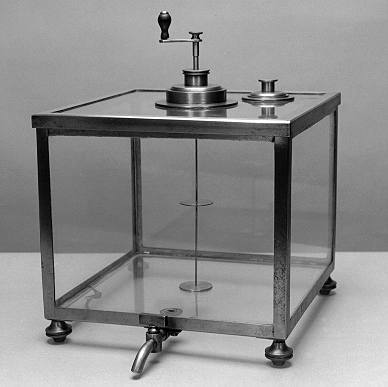In 1873 the paper (in two parts) "Statique expérimentale et théorique des liquides soumis aux seules forces moléculaires" is published. The two parts in fact collect all of Plateau's work on experiments about surface tension in liquids, published between 1842 and 1868 in the form of 11 "mémoires". Though less known to the larger public, this research is in fact a lot more important than any of Plateau's perception experiments.

Apparatus for Plateau's experiment
Photo M.D. Collection J.Plateau, Ghent
In 1840 Bernaert, Plateau's "péparateur" and "conservateur du cabinet
de physique", also an instrument maker, accidentally drops a small amount
of oil into a water-alcohol mixture. Plateau observes with astonishment
that small perfectly spherical oil-droplets are formed. This is the start
of a whole new set of experiments and publications. After Plateau's design,
Bernaert builds an instrument kwown as "Plateau Apparatus".

The experiment goes as follows: oil is deposited along a vertical axis in a tank filled with a mixture of water and alcohol. The oil takes on a spherical form. If the oil and the water-alcohol mixture have the same density the oil sphere freely floats. Then the oil sphere is "not subjected to gravity", as Plateau puts it. If one revolves the axis slowly (one turn every 5 seconds) the oil sphere begins to flatten at the "poles". A maximum of this flattening occurs at 3 to 4 turns per second. If the angular velocity is still larger the oil takes the form of a torus, loose from the axis. At even higher velocities the torus breaks up into small spheres which rotate around their own axis. This experiment with the oil sphere made Plateau's renown world-wide. His works were translated into English. He could not avoid that this experiment was seen as a model for the movement of the planets. Collection J.Plateau, Ghent. .
Plateau wonders which are the forces that generate the
spherical form. Since no gravity acts on the sphere, molecular forces
dominate the process. Plateau proves experimentally that these act in
a very thin surface layer. He knows (from Laplace's theory) that a liquid,
standing on itself, exerts a force on each point of the surface equal
to a constant (which depends on the liquid) multiplied by the mean curvature
of the surface in that point. A number of equilibrium surfaces can thus
arise. In the first place the sphere, as in Plateau's experiment, but
also the cylinder and the flat plane. Plateau finds three other surfaces
of revolution that follow these laws: the onduloid, the nodoid and the
catenoid (names given by Plateau).Plateau wonders which are the forces
that generate the spherical form. Since no gravity acts on the sphere,
molecular forces dominate the process. Plateau proves experimentally that
these act in a very thin surface layer. He knows (from Laplace's theory)
that a liquid, standing on itself, exerts a force on each point of the
surface equal to a constant (which depends on the liquid) multiplied by
the mean curvature of the surface in that point. A number of equilibrium
surfaces can thus arise. In the first place the sphere, as in Plateau's
experiment, but also the cylinder and the flat plane. Plateau finds three
other surfaces of revolution that follow these laws: the onduloid, the
nodoid and the catenoid (names given by Plateau).